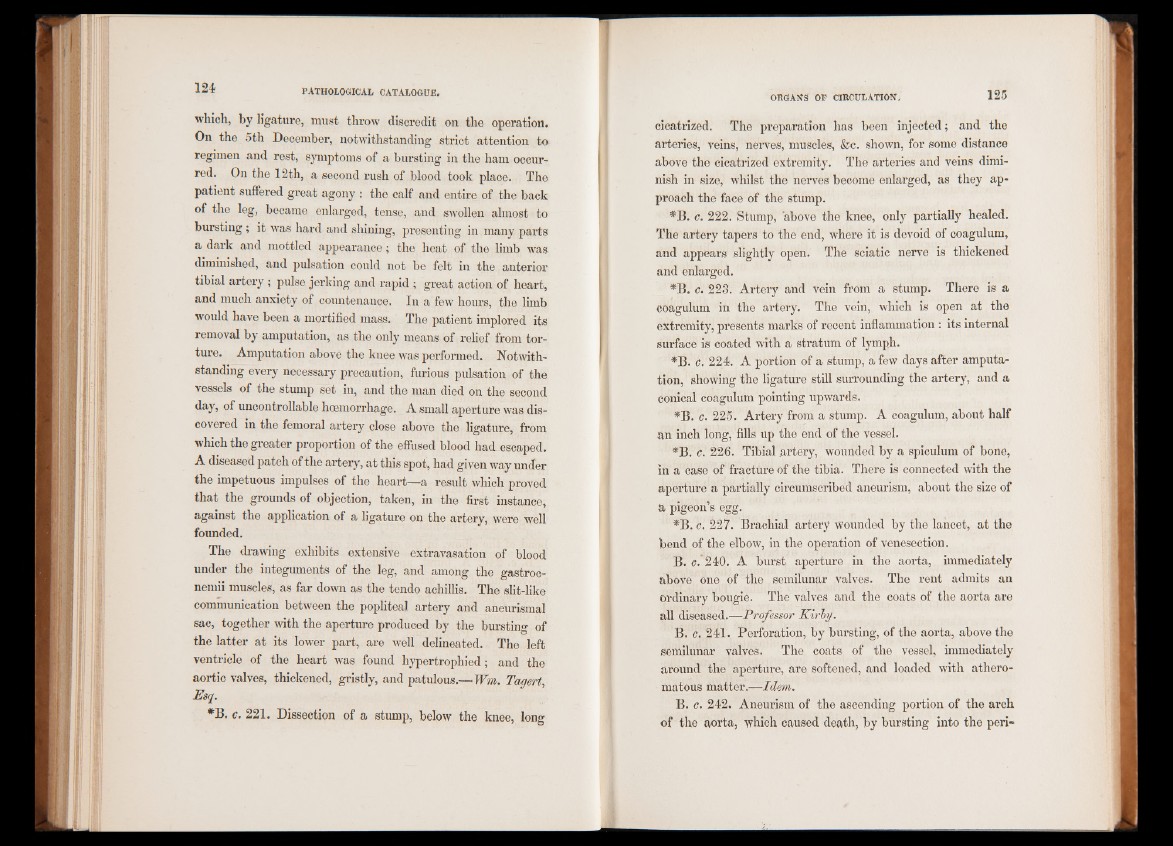
which, by ligature, must throw discredit on the operation.
On the 5th December, notwithstanding strict attention to
regimen and rest, symptoms of a bursting in the ham occurred.
On the 12 th, a second rush of blood took place. The
patient suffered great agony : the calf and entire of the back
of the leg, became enlarged, tense, and swollen almost to
bursting ; it was hard and shining, presenting in many parts
a dark and mottled appearance; the heat of the limb was
diminished, and pulsation could not be felt in the anterior
tibial artery ; pulse jerking and rapid ; great action of heart,
and much anxiety of countenance. In a few hours, the limb
would have been a mortified mass. The patient implored its
removal by amputation, as the only means of relief from torture.
Amputation above the knee was performed. Notwithstanding
every necessary precaution, furious pulsation of the
vessels of the stump set in, and the man died on the second
day, of uncontrollable hoemorrhage. A small aperture was discovered
in the femoral artery close above the ligature, from
which the greater proportion of the effused blood had escaped.
A diseased patch of the artery, at this spot, had given way under
the impetuous impulses of the heart—a result which proved
that the grounds of objection, taken, in the first instance,
against the application of a ligature on the artery, were well
founded.
The drawing exhibits extensive extravasation of blood
under the integuments of the leg, and among the gastroc-
nemii muscles, as far down as the tendo achillis. The slit-like
communication between the popliteal artery and aneurismal
sac, together with the aperture produced by the bursting of
the latter at its lower part, are well delineated. The left
ventricle of the heart was found hypertrophied; and the
aortic valves, thickened, gristly, and patulous.—Wm. Tagert,
Esq.
*B. c. 2 2 1 . Dissection of a stump, below the knee, long
cicatrized. The preparation has been injected; and the
arteries, veins, nerves, muscles, &c. shown, for some distance
above the cicatrized extremity. The arteries and veins diminish
in size, whilst the nerves become enlarged, as they approach
the face of the stump.
#B. c. 222. Stump, above the knee, only partially healed.
The artery tapers to the end, where it is devoid of coagulum,
and appears slightly open. The sciatic nerve is thickened
and enlarged.
*B. c. 223. Artery and vein from a stump. There is a
eoagulum in the artery. The vein, which is open at the
extremity, presents marks of recent inflammation : its internal
surface is coated with a stratum of lymph.
*B. o. 224. A portion of a stump, a few days after amputation,
showing the ligature still surrounding the artery, and a
conical coagulum pointing upwards.
*B. c. 225. Artery from a stump. A coagulum, about half
an inch long, fills up the end of the vessel.
*B. c. 226. Tibial artery, wounded by a spiculum of bone,
in a case of fracture of the tibia. There is connected with the
aperture a partially circumscribed aneurism, about the size of
a pigeon’s egg.
*B. c. 227. Brachial artery wounded by the lancet, at the
bend of the elbow, in the operation of venesection.
B. c.'240. A burst aperture in the aorta, immediately
above one of the semilunar valves. The rent admits an
ordinary bougie. The valves and the coats of the aorta are
all diseased.—Professor Kirby.
B. c. 241. Perforation, by bursting, of the aorta, above the
semilunar valves. The coats of the vessel, immediately
around the aperture, are softened, and loaded with atheromatous
matter.—Idem.
B. c. 242. Aneurism of the ascending portion of the arch
of the aorta, which caused death, by bursting into the peri